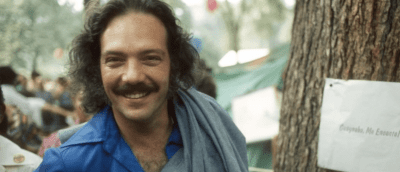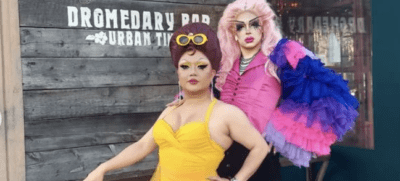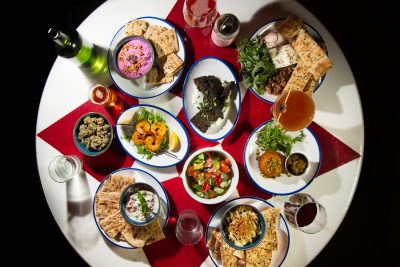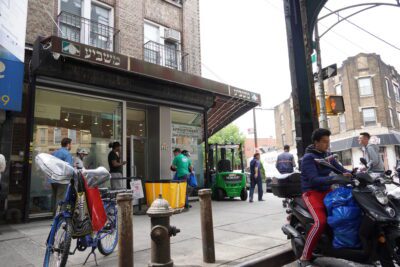Buffy Sainte-Marie at the CBC Music Festival (YouTube)
Buffy Sainte-Marie at Celebrate Brooklyn: An indigenous warrior and ‘observant optimist’
The Canadian-American singer-songwriter discusses her trailblazing career of firsts—including her Brooklyn debut last week
Buffy Sainte-Marie has been a trailblazer for almost 60 years. And last week, she broke new ground once again.
“This is my first time playing in Brooklyn!” she said from the recently-renamed Lena Horne Bandshell stage in Prospect Park on Friday evening. “Thank you for inviting me.”
While new to Brooklyn, Sainte-Marie is of course no stranger to the city. When she stepped out sporting a sequined jacket, she hinted at her history with New York. “I bought this on St. Marks Place when Jimmy Webb had … lingerie,” she said, sequins gleaming through her lucite guitar.
Sainte-Marie, who was performing as part of the BRIC Celebrate Brooklyn! Festival, was an important figure on the Greenwich Village folk scene in the early ‘60s, rubbing shoulders with Bob Dylan and Joni Mitchell. But while many of her contemporaries took their protest songs to the streets, Sainte-Marie offered a different perspective: that of an indigenous Canadian-American woman.
Sainte-Marie was born on the Piapot 75 reserve in Saskatchewan, Canada, then adopted as an infant by an indigenous couple, who raised her just outside Boston. Growing up, she taught herself to play piano and guitar, and by her early 20s she was touring alone and honing her songwriting. One of her first anti-war protest songs, 1963’s “Universal Soldier,” was a significant hit a year later, when it was covered by Donovan. But most of Sainte-Marie’s music shone a spotlight on the plight of Native Americans, with songs like “Now That the Buffalo’s Gone” and “My Country ‘Tis of Thy People You’re Dying.”
Sainte-Marie never intended to become a spokesperson for the indigenous community, but no one else was doing it. She prizes education; in the ‘70s, she turned a one-off appearance on Sesame Street into a semi-residency, teaching kids that indigenous people aren’t artifacts, but living, breathing, vital members of society. She also breastfed her son during a 1977 episode, one of the first representations of breastfeeding on television.
Decades later, Sainte-Marie, who has the energy of someone half her 80 years, still educates and advocates for others. While her Brooklyn set included classics like “Universal Soldier,” newer compositions like “Carry It On,” “You Got to Run,” and “The War Racket” addressed the Iraq war and climate change. A red dress hung on a rack behind her, honoring missing and murdered indigenous women.
“I’m a teacher, so I’m always giving you reading assignments,” she said before encouraging the audience to investigate companions to her work: Jack Weatherford’s “Indian Givers: How the Indians of the Americas Transformed the World,” Dee Brown’s “Bury My Heart at Wounded Knee,” and Andrés Reséndez’s “The Other Slavery: The Uncovered Story of Indian Enslavement in America.”
Just before her performance, Brooklyn Magazine caught up with Sainte-Maire to talk about her activism, scoring free ice cream for life from Ben & Jerry’s with Spike Lee, next steps for addressing injustices against BIPOC communities, and her first impressions of Brooklyn.
This interview has been condensed for clarity and length.
When was the last time you were here in New York?
I lived here for a long time. I used to live in the Village. Then when we were doing “Sesame Street,” I was here for a while and back and forth a lot. If it weren’t for Hawaii, this is where I’d be.
And Brooklyn specifically?
This is my first touring and I just love it.
Really? Where have you been?
I’ve been in the hotel room and Junior’s Diner [laughs]. And I’ve been to the Bedouin Tent and Prospect Park. All I knew about Brooklyn was Spike Lee, which was good enough.
Have you met him?
I did. Spike and I got ice cream for life from Ben and Jerry’s. This was probably in the ’90s and it was me, Spike, who filmed it? Pete Seeger, Father Daniel Berrigan, Bobby Seale who founded the Black Panther Party. Carlos Santana, Michelle Wright, Dolores Huerta who was Farm Workers Union. They gave us ice cream for life because I was running my Cradleboard Teaching Project.
Do you have a favorite flavor?
Yes. Karamel Sutra.
When you were in the Village, the story goes that it was Dylan who encouraged you to sing at the Gaslight?
Well, that’s a bit of a summation. He was just one more guy. He was just around, we were both singers around. He’s such a great writer. I still love him.
A theme in your career seems to be that you’re a sort of accidental activist or pioneer. You were an early advocate for indigenous people, you breastfed on “Sesame Street,” you were an early electronic musician. How deliberate was all of that?
When people look back on something, it’s kind of surprising. It’s somebody else’s movie of your life and you wouldn’t have thought of it yourself. When I started off, I didn’t think I was going to last very long anyway and I was just there because of the content of the songs, not because I was trying to be a singer and I sure never thought I’d wind up in show business of any kind. I guess I was the first person to breastfeed, but that sounds so weird or something. I was breastfeeding anyway.We were doing “Sesame Street,” we’re doing two shows a day with a baby on my hip and I was breastfeeding and I just suggested and I said, “Why don’t we do one on breastfeeding? You just wing it like that. And with indigenous stuff it was who I was, it was the thing that I had to contribute that nobody else was doing. I was singing about things that I really believed in. And one of them happened to be the kind of thinking that eventuated into Universal Soldier. Most people thought Donovan wrote that anyway.
Talk about Pete Seeger.
Oh, very sweet guy. In the ’60s, nobody really had a handle on indigenous anything. At the end of one of his shows that I did, we’re all supposed to come up and hold hands and sing, “this land is your land, this land is my land.” And I didn’t want to do it. And they just said, “Please, please don’t be like that. Just go up and do it.” And I saw him at the end of the festival, he does the River Festival two years before he passed, he finally got it. This land is your land, it used to be my land. He finally got it. So there is no indigenous consciousness in the U.S. There just isn’t any.
What do we do about that?
We have to just work person to person, people to people. We have to work through the media. We have to work without the media. And we’re just not there yet. We don’t have the numbers. But we know how to treat each other. We know how to treat the world. We know how to live in an alternative to the European pecking order.
What are you thinking about now?
Like everybody else I’m scared to death about climate change. A couple of our songs tonight are about that. Black Lives Matter is very, very important. I have to understand, along with other indigenous people, that we’re so far behind that people are aware of Black Lives Matter now and so we all come forward and support them because really it supports everybody. But that does not necessarily address any of the issues with indigenous people today.
It’s a big topic in Canada?
In Canada, we’re addressing a lot of it. In the U.S. we’re addressing none of it. The only thing that you hear is that, up in Minnesota, people were objecting to the pipeline, “All those Indians up there were mad about something.” Unless you raise your fist in the air, it’s hard to get any column space because there’s just so much important stuff going on today. So a lot of us in the indigenous community, it’s just more and more patience. Keep on getting your PhD, writing your books, becoming prima ballerinas, becoming hockey stars, serving your community but don’t expect the media in the U.S. to pay any attention.
You’re a singer, songwriter. Is that still an effective way to send out the message?
For me it is and it always has been. I’ve never been the kind of person to carry a sign in the street and shake my fist at the camera and be mad at everybody. I’m a writer and I had big art exhibits going on in Canada. I have an exhibition in Penticton, Canada, at the moment that show all my huge digital paintings.
What’s the goal tonight? What is the takeaway that you want?
Oh, gosh. I don’t know. People come to a concert for all kinds of reasons. They got nothing to do. They got a hot date. What do we do? They really like the music or they heard that they might like it, or they’ve been fans for years or their parents were fans or their kids were fans or something, so I never know. The band is great. The songs are undeniable. The songs practically have footnotes. “Universal Soldier” or “My Country ‘Tis Of Thy People You’re Dying,” I’ve got annotated versions of them online that people can look at.
Do you have a moment that you’re most proud of when you look back?
Yeah, but it wouldn’t be something that you’d know about. It wasn’t my Academy Award or Polaris Prize or anything. It was when I found out that two of my early scholarship recipients from my Nihewan Foundation actually went on to become the founders and presidents of tribal colleges.
Amazing.
I had given them scholarships in the ’60s and they went to create The World Indigenous Higher Education Network, WINHEC. They went on to found The American Indian Tribal College System. An Academy Award is an ego trip, but to actually pass something on that you believe in to somebody else than you believe in and they go out and, holy smoke, they maximize it just beyond your wildest dream. So that’s the nicest thing that ever happened to me.
I would imagine that’s the net effect of your music as well, with your career and your messages dating back to the ‘60s.
A little bit. A little bit.
You sounded disappointed just now.
Certainly if I had not been blacklisted, I know for sure that I would have been effective at a different level. And I think that’s what all of us who were active in the ’60s, the ’70s and the ’80s, just being gagged and to be denied radio play, to be cut off from an audience who were really eager to learn, that hurts. What are you going to do about people like J. Edgar Hoover, Richard Nixon? Just the blacklisting of me or Taj [Mahal] or Eartha Kitt—it’s on White House stationary what they did to us. They shouldn’t be able to do that because the content that we’re providing is important. But to them, it’s just one more task to shut that up, to shut it down, some of it. But, COINTELPRO, that’s what it was about.
Are you ultimately an optimist, though?
I am. Man, I hurt too. Let’s say I’m an observant optimist. Yeah. I’m old enough to know that not everybody is my friend. I used to think they all were, but I know better now. It’s challenging.
You might also like 


























